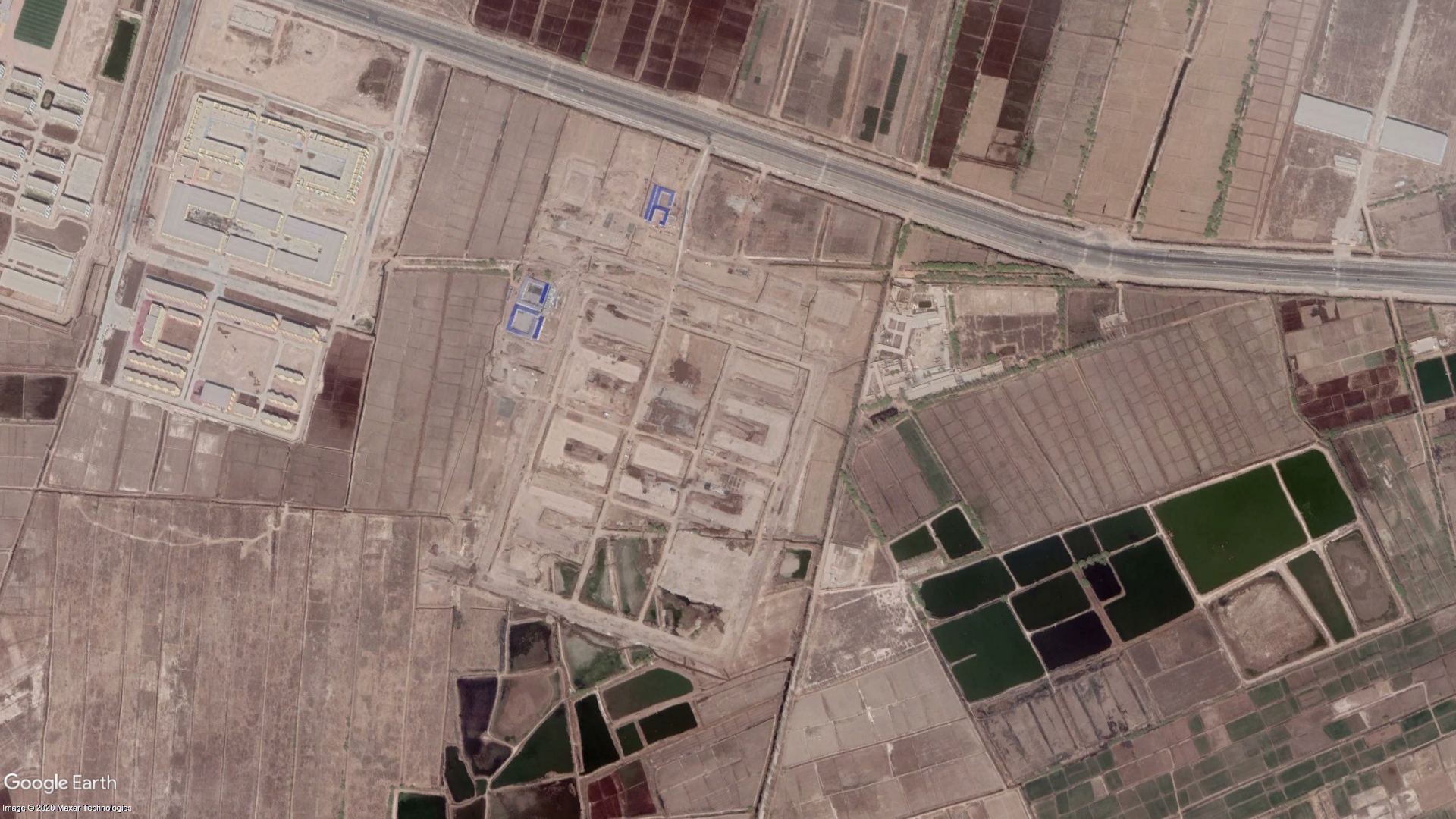
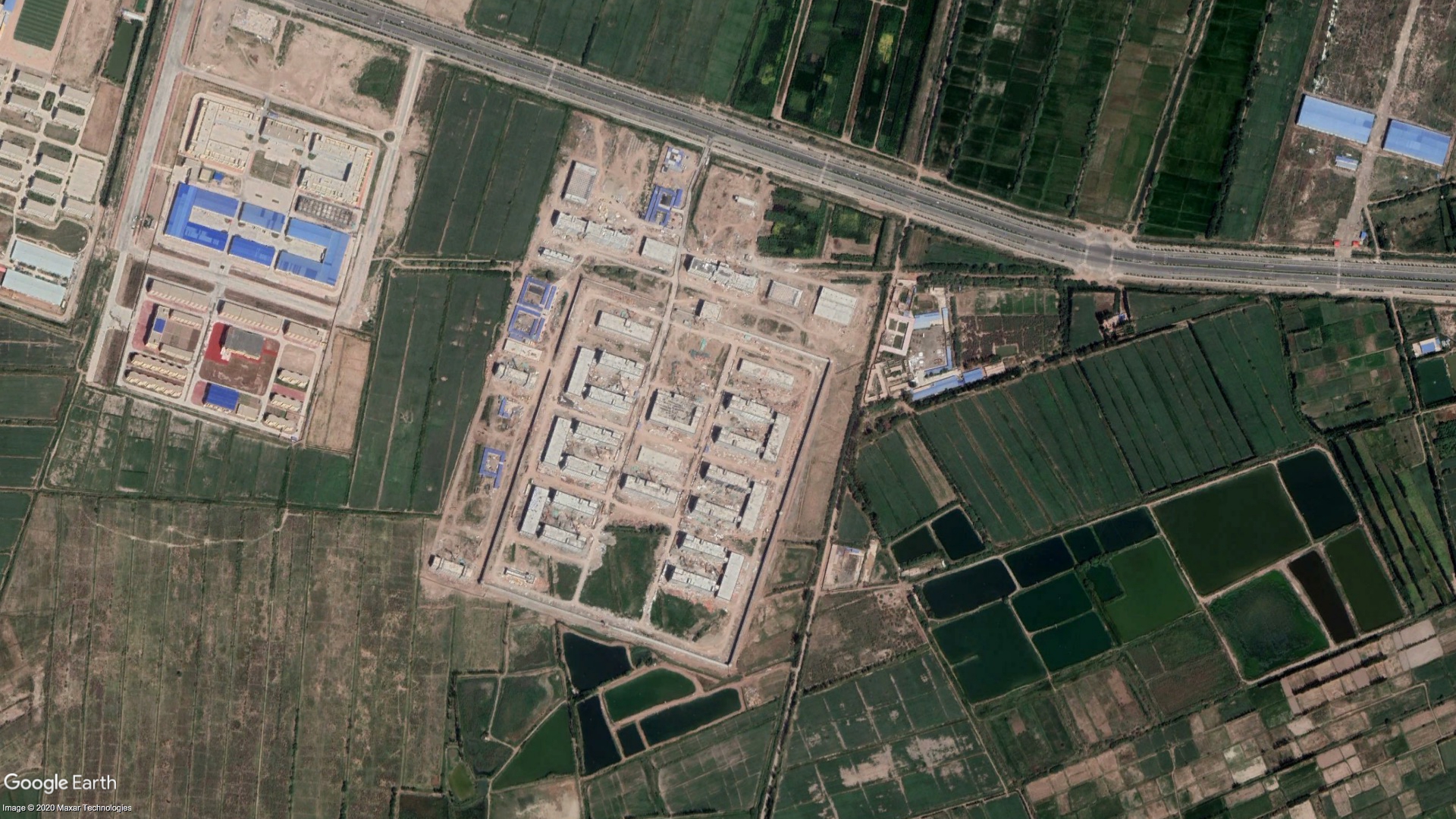
This has hardly been in response to a real active threat. Leaving things be saves a lot of money and generates revenue as well
Is this the plan for all non Han peoples as well? What will happen to the tibetans?
What is the outcome? Are these people returned to their communities? The outside world remains in ignorance.
Western China has never belonged to China, any more than the Sahara and Africa has belonged to Europe. Real absorption is expensive and difficult and realistically genocidal.
China rounded up so many Muslims in Xinjiang that there wasn’t enough space to hold them.
OCTOBER 7, 2019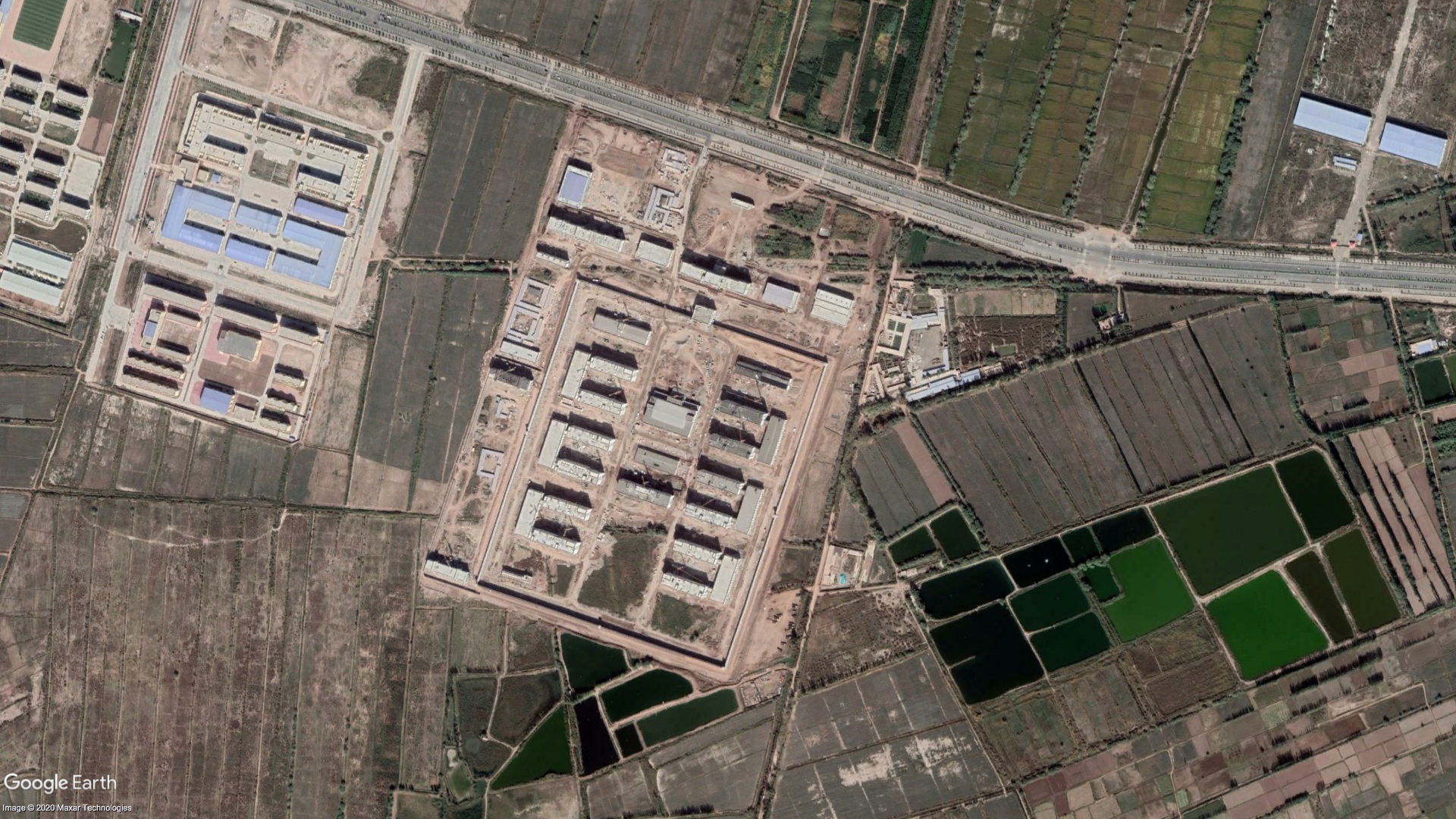

Then the government started building.
JANUARY 29, 2020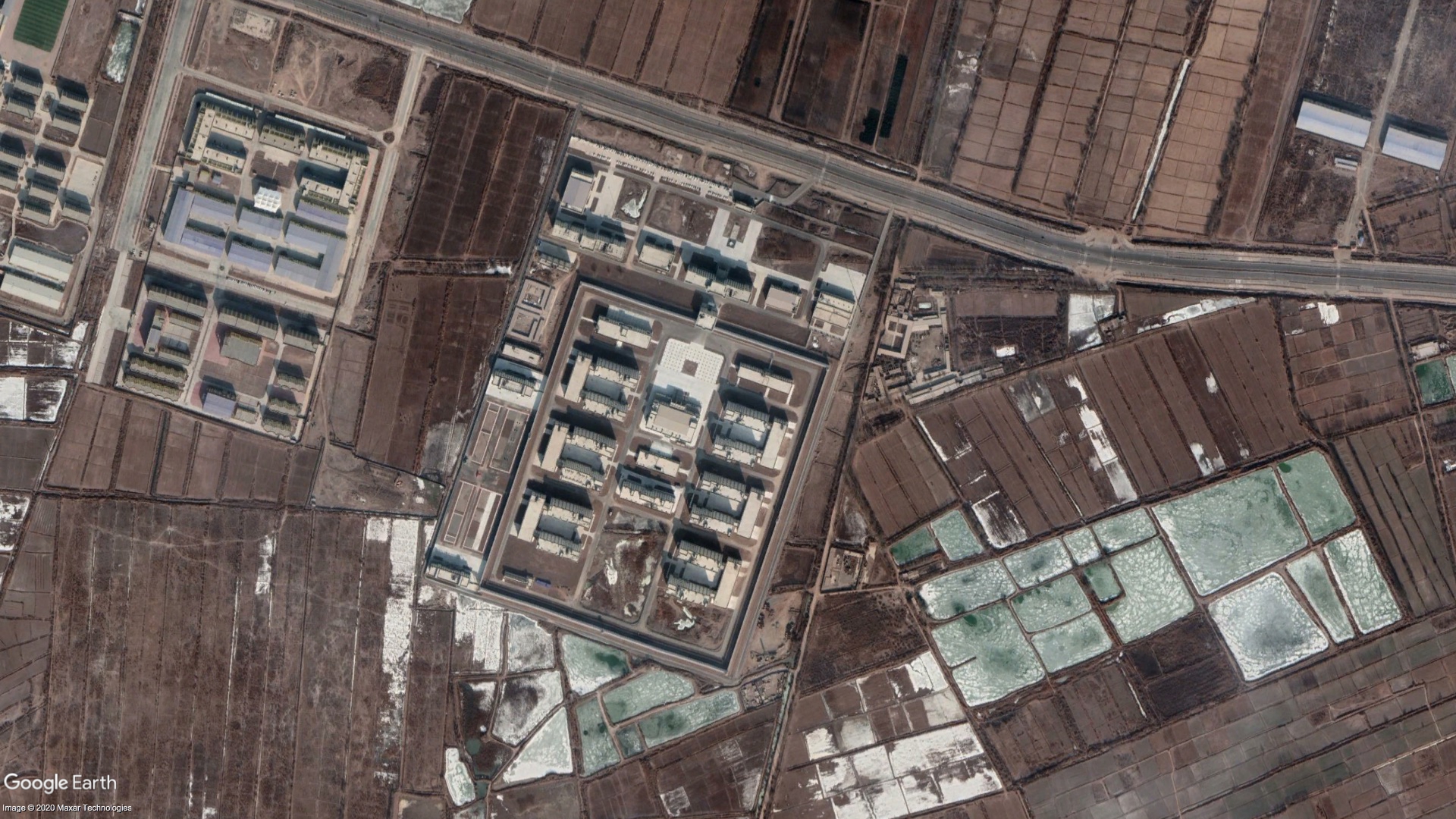

This massive new compound in the county of Shufu is capable of housing 10,000 people. There are many others.
APRIL 26, 2020
BUILT TO LAST
A BuzzFeed News investigation based on thousands of satellite images reveals a vast, growing infrastructure for long-term detention and incarceration.
Posted on August 27, 2020, at 6:00 a.m. ET
This is Part 1 of a BuzzFeed News investigation. For Part 2, click here.
This project was supported by the Open Technology Fund, the Pulitzer Center, and the Eyebeam Center for the Future of Journalism.
China has secretly built scores of massive new prison and internment camps in the past three years, dramatically escalating its campaign against Muslim minorities even as it publicly claimed the detainees had all been set free. The construction of these purpose-built, high-security camps — some capable of housing tens of thousands of people — signals a radical shift away from the country’s previous makeshift use of public buildings, like schools and retirement homes, to a vast and permanent infrastructure for mass detention.
In the most extensive investigation of China’s internment camp system ever done using publicly available satellite images, coupled with dozens of interviews with former detainees, BuzzFeed News identified more than 260 structures built since 2017 and bearing the hallmarks of fortified detention compounds. There is at least one in nearly every county in the far-west region of Xinjiang. During that time, the investigation shows, China has established a sprawling system to detain and incarcerate hundreds of thousands of Uighurs, Kazakhs, and other Muslim minorities, in what is already the largest-scale detention of ethnic and religious minorities since World War II.
These forbidding facilities — including several built or significantly expanded within the last year — are part of the government’s unprecedented campaign of mass detention of more than a million people, which began in late 2016. That year Chen Quanguo, the region’s top official and Communist Party boss, whom the US recently sanctioned over human rights abuses, also put Muslim minorities — more than half the region’s population of about 25 million — under perpetual surveillance via facial recognition cameras, cellphone tracking, checkpoints, and heavy-handed human policing. They are also subject to many other abuses, ranging from sterilization to forced labor.
To detain thousands of people in short order, the government repurposed old schools and other buildings. Then, as the number of detainees swelled, in 2018 the government began building new facilities with far greater security measures and more permanent architectural features, such as heavy concrete walls and guard towers, the BuzzFeed News analysis shows. Prisons often take years to build, but some of these new compounds took less than six months, according to historical satellite data. The government has also added more factories within camp and prison compounds during that time, suggesting the expansion of forced labor within the region. Construction was still ongoing as of this month.
“People are living in horror in these places,” said 49-year-old Zhenishan Berdibek, who was detained in a camp in the Tacheng region for much of 2018. “Some of the younger people were not as tolerant as us — they cried and screamed and shouted.” But Berdibek, a cancer survivor, couldn’t muster the energy. As she watched the younger women get dragged away to solitary confinement, “I lost my hope,” she said. “I wanted to die inside the camp.”
BuzzFeed News identified 268 newly built compounds by cross-referencing blanked-out areas on Baidu Maps — a Google Maps–like tool that’s widely used in China — with images from external satellite data providers. These compounds often contained multiple detention facilities.
This map shows the locations of facilities bearing the hallmarks of prisons and internment camps found in this investigation. Note: Many satellite images in this map are from before 2017, meaning that although you can zoom in, you won’t always be able to see the evidence of possible camps.
Locations identified or corroborated by other sources. Satellite images — perimeter walls and guard towers. Satellite images — walls and barbed wire but no guard towers. Detention Center built before 2017. Likely used for detention in the past but now closed or reduced security.
Ninety-two of these facilities have been identified or verified as detention centers by other sources, such as government procurement documents, academic research, or, in 19 cases, visits by journalists.
Another 176 facilities have been established by satellite imagery alone. The images frequently show thick walls at the perimeter, and often, barbed wire fencing that creates pens and corridors in the courtyards. Many compounds in the region are walled, but the facilities identified by BuzzFeed News have much heavier fortifications. At 121 of these compounds, they also show guard towers, often built into the perimeter wall.
In response to a detailed list of questions about this article as well as a list of GPS coordinates of facilities identified in this article, the Chinese Consulate in New York said “the issue concerning Xinjiang is by no means about human rights, religion or ethnicity, but about combating violent terrorism and separatism,” adding that it was a “groundless lie” that a million Uighurs have been detained in the region.
“Xinjiang has set up vocational education and training centers in order to root out extreme thoughts, enhance the rule of law awareness through education, improve vocational skills and create employment opportunities for them, so that those affected by extreme and violent ideas can return to society as soon as possible,” the consulate added, saying human rights are protected in the centers and that “trainees have freedom of movement.” But it also compared its program to “compulsory programs for terrorist criminals” it said are taking place in other countries including the US and UK.
China's Foreign Ministry and Baidu did not respond to repeated requests for comment.
The new facilities are scattered across every populated area of the region, and several are large enough to accommodate 10,000 prisoners at a minimum, based on their size and architectural features. (One of the reporters on this story is a licensed architect.)
Unlike early sites, the new facilities appear more permanent and prisonlike, similar in construction to high-security prisons in other parts of China. The most highly fortified compounds offer little space between buildings, tiny concrete-walled yards, heavy masonry construction, and long networks of corridors with cells down either side. Their layouts are cavernous, allowing little natural light to the interior of the buildings. BuzzFeed News could see how rooms were laid out at some high-security facilities by examining historical satellite photos taken as they were being constructed, including photos of buildings without roofs.
With at least tens of thousands of detainees crowded into government buildings repurposed as camps by the end of 2017, the government began building the largest new facilities in the spring of 2018. Several were complete by October 2018, with further facilities built through 2019 and construction of a handful more continuing even now.
The government has said its camps are schools and vocational training centers where detainees are “deradicalized.” The government’s own internal documentation about its policies in Xinjiang has used the term “concentration,” or 集中, to describe “educational schools.”
ADVERTISEMENT
The government claims that its campaign combats extremism in the region. But most who end up in these facilities are not extremists of any sort.
Downloading WhatsApp, which is banned in China, maintaining ties with family abroad, engaging in prayer, and visiting a foreign website are all offenses for which Muslims have been sent to camps, according to previously leaked documents and interviews with former detainees. Because the government does not consider internment camps to be part of the criminal justice system and none of these behaviors are crimes under Chinese law, no detainees have been formally arrested or charged with a crime, let alone seen a day in court.
The compounds BuzzFeed News identified likely include extrajudicial internment camps — which hold people who are not suspected of any crime — as well as prisons. Both types of facilities have security features that closely resemble each other. Xinjiang’s prison population has grown massively during the government’s campaign: In 2017, the region had 21% of all arrests in China, despite making up less than 2% of the national population — an eightfold increase from the year before, according to a New York Times analysis of government data. Because China’s Communist Party–controlled courts have a more than 99% conviction rate, the overwhelming majority of those arrests likely resulted in convictions.
“One day I saw a pregnant woman in shackles. Another woman had a baby in her arms, she was breastfeeding.”
People detained in the camps told BuzzFeed News they were subjected to torture, hunger, overcrowding, solitary confinement, forced birth control, and a range of other abuses. They said they were put through brainwashing programs focusing on Communist Party propaganda and made to speak only in the Chinese language. Some former detainees said they were forced to labor without pay in factories.
The government heavily restricts the movements of independent journalists and researchers in the region, and heavily censors the internet and its own domestic media. Muslim minorities can be punished for posts on social media. But satellite images that are collected from independent providers remain outside the scope of Chinese government censorship.
Other kinds of evidence have also occasionally leaked out. In September, a drone video emerged showing hundreds of blindfolded men with their heads shaven and their arms tied behind their backs, wearing vests that say “Kashgar Detention Center.” Nathan Ruser, a researcher at the Australian Strategic Policy Institute who has done extensive satellite imagery analysis of the detention and prison systems in Xinjiang, said the video shows a prisoner transfer that took place in April 2019 — months after the government first said the system was for vocational training. Previous analyses, including by the Australian Strategic Policy Institute in November 2018, identified several dozen early camps.
“The internment and assimilation program in Xinjiang has the overall logic of colonial genocides in North America, the formalized racism of apartheid, the industrial-scale internment of Germany's concentration camps, and the police-state penetration into everyday life of North Korea,” said Rian Thum, a scholar of the history of Islam in China at the University of Nottingham.
The campaign has done deep damage to many Muslim minority groups — but especially Uighurs, who are by far the most populous ethnic minority group in Xinjiang and do not have ties to any other country. The Chinese government has heavily penalized expressions of Turkic minority culture, from Kazakh- and Uighur-language education to the practice of Islam outside of state-controlled mosques. This, combined with forced sterilizations, has led some critics to say that the campaign qualifies as genocide under international law. The Trump administration is reportedly discussing whether to formally call it a genocide, and a spokesperson for Joe Biden, the Democratic nominee for president, said on Tuesday that Biden supports the label.
“These are peaceful people in concentration camps,” said Abduweli Ayup, a Uighur linguist who was jailed and later exiled from Xinjiang after opening kindergartens that taught Uighur children in their own language. “They are businessmen and scholars and engineers. They are our musicians. They are doctors. They are shopkeepers, restaurant owners, teachers who used Uighur textbooks.
“These are the pillars of our society. Without them, we cannot exist.”
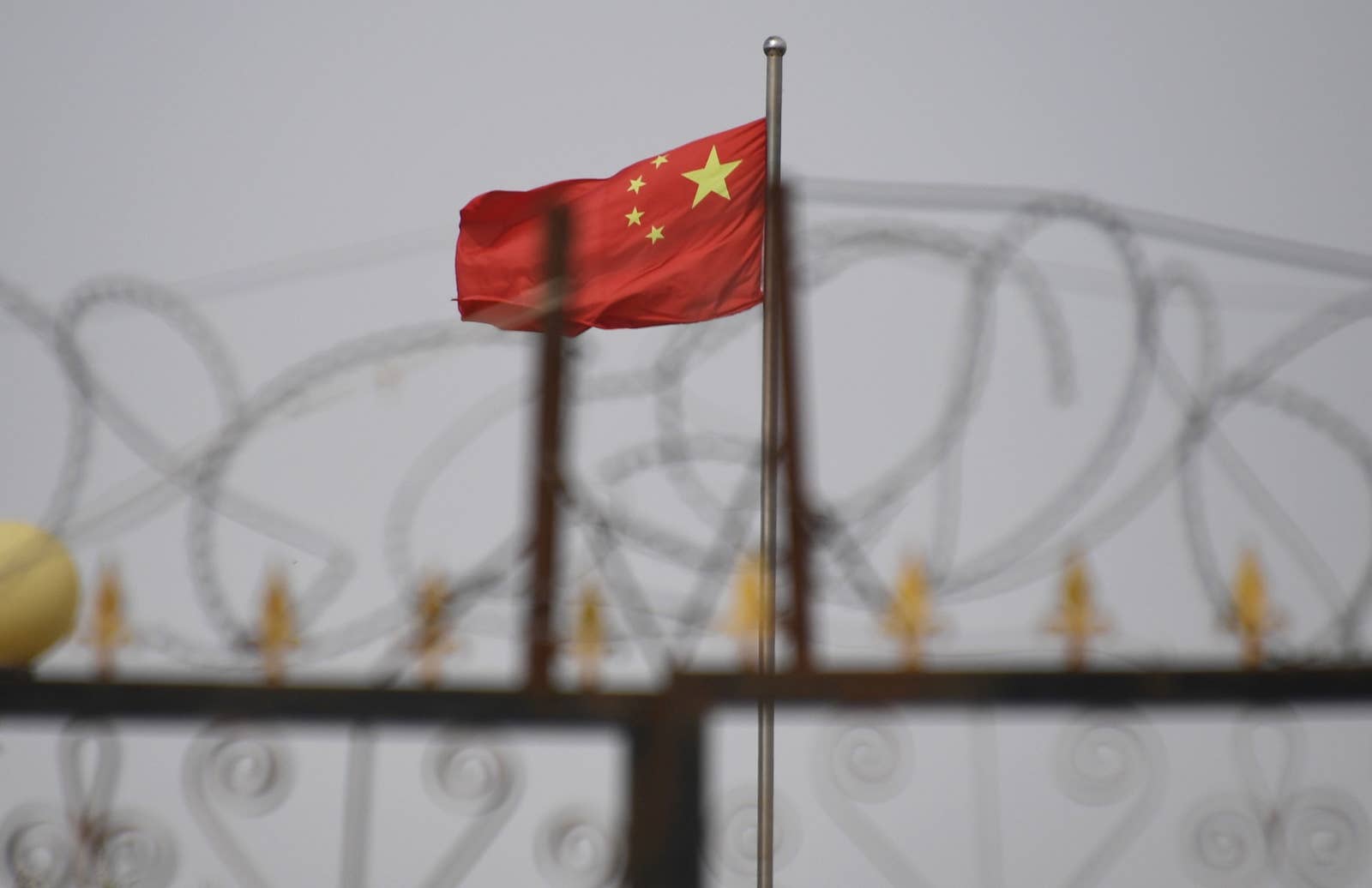
Greg Baker / Getty Images
The Chinese flag is seen behind razor wire at a housing compound in Yangisar, south of Kashgar, in China's western Xinjiang region, June 4, 2019.
ADVERTISEMENT
The position of Muslim minorities, particularly Uighurs, in China has been fraught since the Communist Party came to power in 1949. But conditions deteriorated quickly starting in 2016, when the government implemented a system of heavy-handed surveillance and policing as a means to push Muslims into a growing internment camp system for “transformation through education.” Chen, the region’s party boss, called on officials to “round up everyone who should be rounded up.”
Thousands were. Tursunay Ziyawudun, who was detained in March 2018, was one of them. When she arrived at the camp’s gates, she saw hundreds of people around her removing their jewelry, shoelaces, and belts. They were being “processed,” she said, to enter the camp through a security checkpoint.

Courtesy Tursenay Ziyawudun
Tursenay Ziyawudun in an undated handout photo.
Early on, the government remade schools, retirement homes, hospitals, and other public buildings into internment camps. There were other, older detention centers available too — BuzzFeed News identified 47 built before 2017 that have been used to lock people up in the region.
Some detention facilities are geared toward releasing detainees after several months; in others, detainees may be sentenced to prison terms, said Adrian Zenz, a leading researcher on the abuses in Xinjiang. Three former detainees interviewed by BuzzFeed News said they were held for months in detention without any charges against them — far longer than is allowed by law — before they were transferred to internment camps. The detentions picked up speed in 2017, and numbers in the camps quickly swelled until the inmates were living on top of each other.
BuzzFeed News interviewed 28 former detainees from the region, many of whom described being blindfolded and handcuffed, much like the men shown in the video. Many spoke through an interpreter. They are among a tiny minority of former detainees who were released and left the country — but they described a brutal system that they saw growing and changing with their own eyes.
Most recalled being frequently moved from camp to camp — a tactic that many believed was meant to combat overcrowding in the first generation of makeshift facilities. At the beginning of the campaign, hundreds of people were arriving on a daily basis. New batches of detainees always seemed to be coming and going.
Some former detainees described sleeping two to a twin bed, or even sleeping in shifts when there was not enough room to house all the detainees. Almost all said they received meager quantities of rice, steamed buns, and porridge, and little or no meat or other protein.
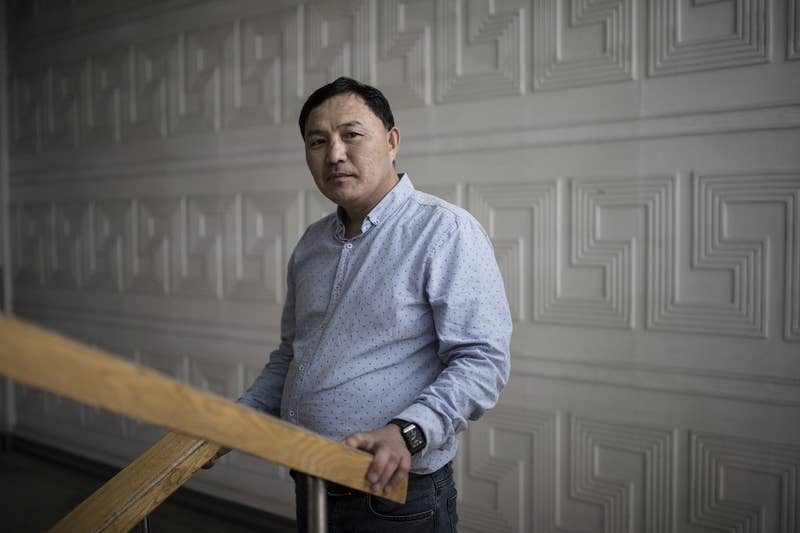
Ekaterina Anchevskaya For BuzzFeed News
Orynbek Koksybek in Human Rights Initiative office where he works in Almaty, Kazakhstan, Feb. 27.
Orynbek Koksebek, a 40-year-old ethnic Kazakh, was first detained relatively early in the campaign, around the end of 2017. At first, he slept in a room with seven other men, and everyone had a bed to themselves. But within a few months, he began to notice more and more people arriving. “One day I saw a pregnant woman in shackles,” he said. “Another woman had a baby in her arms, she was breastfeeding.”
By February 2018, there were 15 men in his room, he said.
“Some of us had to share blankets or sleep on the floor,” he said. “They told us later that some of us would be given prison sentences or transferred to other camps.”
Camp officials regularly forced detainees to memorize Communist Party propaganda and Chinese characters in classrooms. But some former detainees said their facilities were too crowded for even this — instead, they had to sit on plastic stools next to their beds and stare at textbooks, sitting with their backs perfectly straight while cameras monitored them. Camp guards told them there were too many people to fit in classrooms.
For Koksebek, the claustrophobia was unbearable.
“There was a window in our room, but it was so high I couldn’t see much other than a patch of sky,” he said. “I used to wish I were a bird so I could have the freedom to fly.”

Main wall with two layers
of barbed wire on either side
The camp at Shufu, in Xinjiang, seen by satellite on April 26, 2020. BuzzFeed News; Google Maps
On a frigid, overcast morning last December, Shohrat Zakir, the region’s governor and second-most-powerful official, gave a rare press conference at China’s State Council Information Office, located in a closed compound in central Beijing. The office is one of only a handful of government bodies in China that regularly briefs both local and international journalists, and Zakir sat with four other officials at a long podium at the front of the small room. The officials took the opportunity to tout the region’s economic growth and claim China’s campaign against terrorism in Xinjiang has been a success, calling the US government hypocritical for its criticism of China’s human rights abuses. But Zakir was the one who made international headlines.
Of those held in the camps as “trainees,” Zakir painted a rosy picture. They “have all graduated, and have realized stable employment with the government’s help, improved their quality of life, and are enjoying a happy life,” he said.
Even as reporters were scribbling down his remarks, about 2,500 miles away in Xinjiang, construction was wrapping up on a massive high-security compound near the Uighur heartland county of Shufu, just south of a winding river that flows through a countryside dotted by livestock farms. Shufu is small by Chinese standards, with a population of about 300,000 people. It has a main drag with a post office, a lottery ticket vendor, and eateries selling steamed buns and beef noodle soup. The camp was built on farmland less than a 20-minute drive away.
Before workers started construction last March, the land beneath the Shufu site was farmland too, blanketed with green vegetation. By August, workers had built a thick perimeter enclosure, with guard towers looming in the corners and in the center of walls that rise nearly 6 meters, or more than 19 feet, satellite images show. Next came the buildings inside, organized in U-shaped groups, with two five-story structures alongside a two-story one forming the base of the U. By October, two rows of barbed wire fencing appeared on either side of the main concrete-walled compound, its shadow visible in satellite images.
Just outside the walls, on the western side of the compound, two guard buildings were built — distinguished by the narrow walled pathways leading from them up to the wall that would allow guards to access the guard towers and the tops of the walls for patrols. In front of the entrance, a series of buildings provided space for prison offices and police buildings. In total BuzzFeed News estimates that there is room for approximately 10,500 prisoners at this compound — which would help provide a long-term solution to overcrowding.
“I wasn’t happy or sad. I couldn’t feel anything. Even when I was reunited with my relatives in Kazakhstan, they asked me why I didn’t seem happy to see them after so long.”
Ruser reviewed satellite images of the compound and said it was a newly built detention camp. “The vast majority of camps have watchtowers, internal fencing, and a strong external wall entranceway or exit,” he said.
Unlike the old, repurposed camps, new prisons and camps such as this one have higher security, with gates up to four stories tall and thicker walls along their borders, often with further layers of barbed wire on either side of the main walls. These features suggest they are capable of holding much larger groups of people in long-term detention.
The camps can contain not only cells where detainees sleep, but also classrooms, clinics, canteens, stand-alone shower facilities, solitary confinement rooms, police buildings, administrative offices, and small visitor centers, former detainees told BuzzFeed News. Many of the compounds also contain factories, distinguished by their blue, powder-coated metal roofs and steel frames, which are visible in satellite photos taken while they were being constructed. The police buildings, including for guards and administrative personnel, are usually located by the entrances of the compounds.
The locations of these camps and prisons in Xinjiang are not readily available. However, blanked-out portions of maps on China's Baidu make it possible to use satellite imagery to find and analyze them.
Satellite maps, like Google Earth, are made up of a grid of rectangular tiles. On Baidu, the Chinese search giant that has a map service much like Google’s, BuzzFeed News discovered that spaces containing camps, military bases, or other politically sensitive facilities were overlaid with plain light gray tiles. These “mask” tiles appeared upon zooming in on the location. These look different from the darker gray, watermarked tiles that appear when Baidu cannot load something. The “mask” tiles were also present at other locations where camps had been visited and verified by journalists, though they have since been removed.
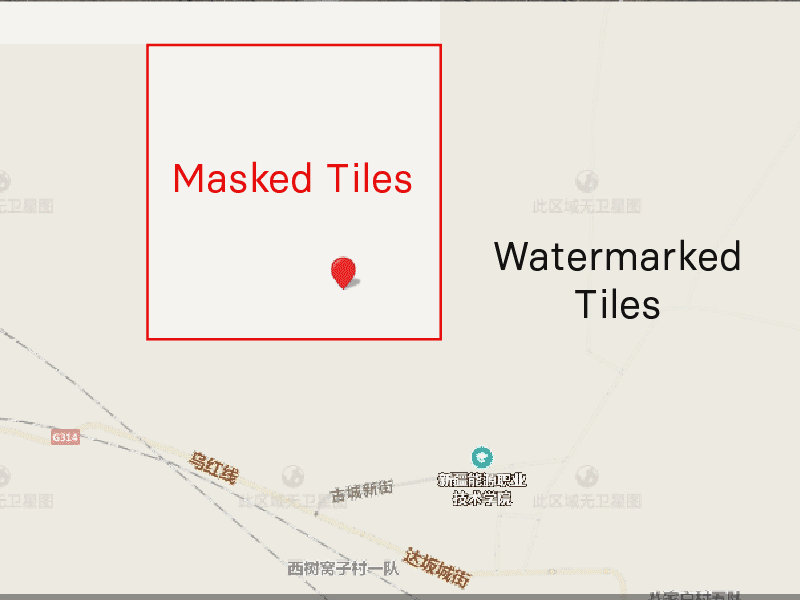
Dabancheng District, Ürümqi Prefecture
Baidu; Planet Labs
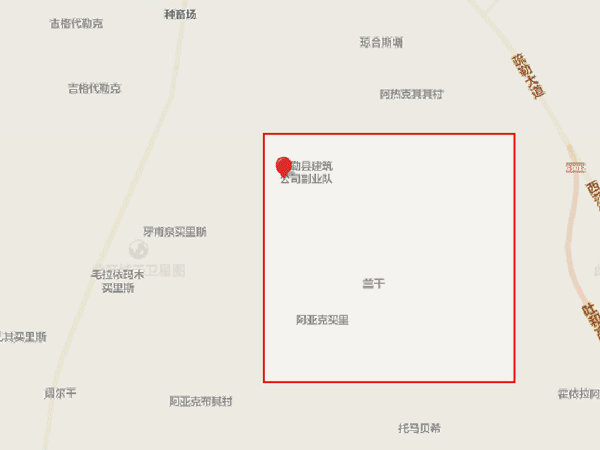
Shule County, Kashgar Prefecture
Baidu; Planet Labs
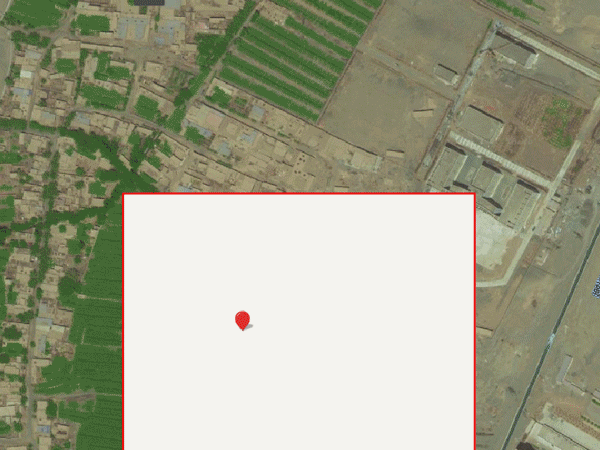
Gaochang District, Turpan Prefecture
Baidu; Planet Labs
BuzzFeed News identified the compounds using other satellite maps — provided by Google Earth, Planet Labs, and the European Space Agency’s Sentinel Hub — which do not mask those images. For some locations where high-resolution images were not publicly available, Planet Labs used its own satellite to take new pictures, then provided them to BuzzFeed News. Read more here about how this investigation was conducted.
The images showed the facilities being built over a period of months. Details from the images offer a sense of size and scale: Counting the number of windows in building facades, for example, shows how many stories they contain.
Often, these compounds were built next door to an older prison, sharing parking lots, administrative facilities, and police barracks with the older facility, satellite images show.
BuzzFeed News found an additional 50 more compounds that were likely used for internment in the past but have lost some security features, including barbed wire fencing within compounds used to create rectangular pens, closed passages between buildings, and guard towers, with a small number having been demolished.
Ruser and other experts said this does not suggest the Chinese government is pulling back from its campaign. Many of those facilities likely still operate as low-security camps, he said. The far more important trend in Xinjiang, he said, is the government’s increased use of higher-security prisons and detention facilities.
In response to questions, the Chinese Consulate in New York echoed Zakir's December statement.
"All trainees who received courses in standard spoken and written Chinese, understanding of the law, vocational skills, and deradicalization have completed their training, secured stable employment in the society, and are living a normal life," it said.
Nurlan Kokteubai at his home in Shonzhy, Kazakhstan, Feb. 26.
All of the detainees interviewed by BuzzFeed News were released too long ago to have spent any time in one of the brand-new facilities — many said that before they escaped China for good, they were kept under de facto house or town arrest, unable to venture past the borders of their villages without obtaining permission from a police officer. Many — especially those with less formal education — had no idea what type of facility they were held in or even why they had been detained in the first place. They said they often drew conclusions based on weekly interrogation sessions, where police asked about actions that made them “untrustworthy.”
An older ethnic Kazakh man named Nurlan Kokteubai recognized the camp he was taken to as soon as he arrived in September 2017. Not long before, it had been a middle school.
“My daughter went to that school,” he said. “I had picked her up there before.”

Bitter Winter
The front entrance of the former Third Middle School in Qapqal Xibe, where Kokteubai's daughter went to school.
Smile lines appear on Kokteubai’s deeply wrinkled face when he talks about his daughter, who was born in 1992. She later moved to Kazakhstan, where many ethnic Kazakhs from China emigrate because of the Kazakh government’s resettlement policy for people of Kazakh descent. There, she and her husband campaigned relentlessly for Kokteubai’s release in YouTube videos and long letters to human rights groups. He believes his eventual release in March 2018 was due to her campaign. Inside the camp, instead of classrooms where students like his daughter might have studied math or history, Kokteubai saw dorm rooms overcrowded with as many as 40 or 50 men each sleeping on too few bunk beds.
Though the compound itself wasn’t new, it had many updated features, such as high walls and barbed wire around the compound. And the camp was now dotted with CCTV cameras, which a guard told him could film objects as far as 200 meters away.
Another thing that was new: When you entered the gate, a huge red plaque greeted you. “Let’s learn the spirit of the 19th Communist Party Congress,” it said.
Like Kokteubai, several former detainees interviewed by BuzzFeed News said after arriving, they recognized the facilities in which they were held because they had walked or driven past them, or even visited them in their previous incarnations. But these repurposed facilities were never meant to house prisoners and were not big enough to hold all the Muslim minorities the Chinese government intended to detain.
In early 2019, workers started clearing land to expand a camp south of Ürümqi, in a town called Dabancheng, that had become infamous after reporters from BBC and Reuters visited the year before. The camp at Dabancheng was already one of the largest internment facilities in the region, capable in October 2018 of housing up to 32,500 people, according to an architectural analysis by BuzzFeed News. Since the expansion, it is now capable of housing some 10,000 more people. By November of last year another, separate compound had been completed, this one capable of holding a further 10,000 people — for a total capacity of more than 40,000, comparable to the size of the town of Niagara Falls.
"These facilities display characteristics consistent with extrajudicial detention facilities in the Xinjiang region that CSIS has previously analyzed," said Amy Lehr, director of the human rights program at Washington DC-based think tank CSIS after examining the three camps referenced in this article.
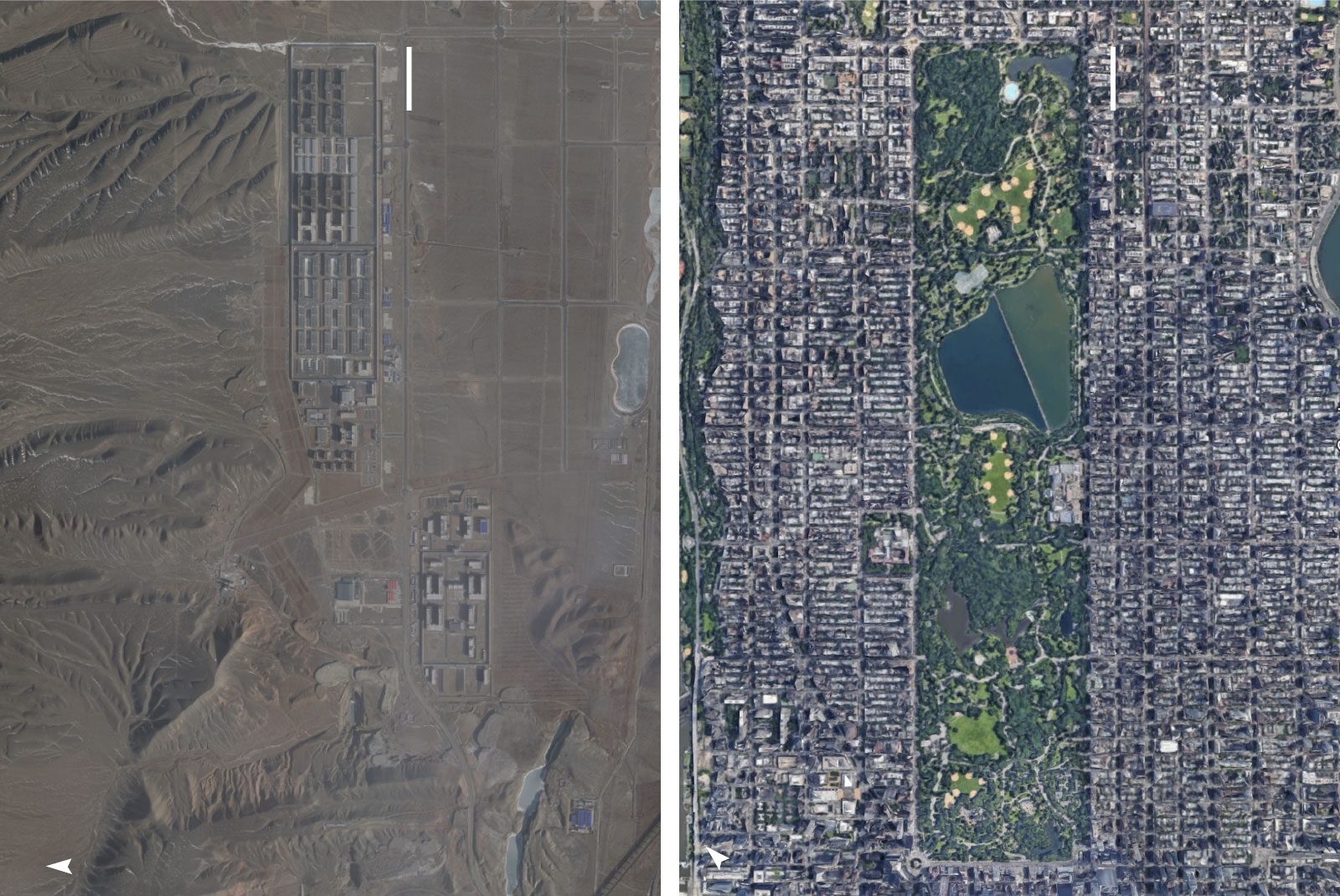
The camp at Dabancheng, Ruser said, “is the main catchment camp for Ürümqi. It’s 2 km (1.2 miles) long and was expanded late last year an extra kilometer with a new facility across the road to the west.” By comparison, the camp is about half the length of Central Park.
Kokteubai never found out precisely why he was detained. Because he’s ethnic Kazakh, he was eventually able to settle in Kazakhstan.
On the day he was released, he expected to feel joy, relief, something. Instead he felt nothing at all.
“I wasn’t happy or sad. I couldn’t feel anything,” he said. “Even when I was reunited with my relatives in Kazakhstan, they asked me why I didn’t seem happy to see them after so long.”
No comments:
Post a Comment